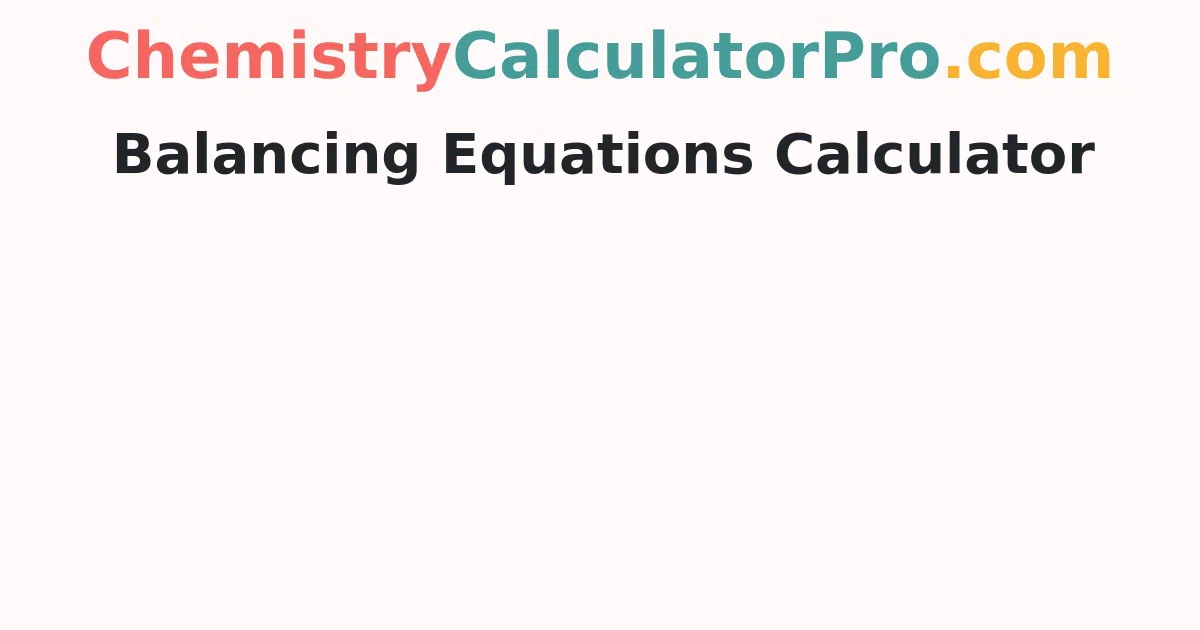Balancing Equations Calculator
The online calculator for balancing chemical equations makes it simple to balance chemical equations. Start typing the chemical formulas in the text box and hit the calculation button to get instant results.
How to Balance Chemical Equations?
We'll show you how to balance any chemical equation in five easy steps. Follow these steps quickly and simply balance your equation.
- Count how many atoms there are on either side of the equation.
- Check the atomic coefficients and insert any number n as a coefficient for the appropriate atoms to balance the equation.
- You can only put the coefficient at the front of the reactant or product, and you can't change the elements' subscripts.
- Check that the number of atoms on the left side equals the number of atoms on the right side after you've added the coefficients.
- To make the equation balanced, change the coefficients for the necessary atoms.
- Treat each polyatomic ion as though it were a single thing when working with polyatomic ions.
- To get a balanced chemical equation, add coefficients to those items.
- Even if the chemical formula contains polyatomic ions, count all atoms in the equation and add coefficients to reach the balanced equation.
Methods to Balance Chemical Equations
Chemical equations can be balanced in number of ways and all of them are described below.
- Approach of inspection, often known as the "hit and trial" method
- Algebraic approach
- Arcesio Garcia proposed a method.
- Method for changing the oxidation number
- Half-reaction method, or ion-electron method
This chemical equation balancing uses the algebraic technique, which is typically rather difficult for hand calculations but works wonderfully for the computer application.
The algebraic technique is founded on the Law of Mass Conservation, which states that matter cannot be generated or destroyed. As a result, each side of a chemical equation must have the same number of each sort of atom. The process of balancing chemical equations ensures that matter is conserved. So all you have to do now is solve a set of algebraic equations that express the number of atoms in each element participating in the reaction. As a result, this approach might be used for any chemical reaction.
Examples on Balancing Chemical Equations
Example 1:
Balance the Chemical Equation N22 + H2 ➝ NH3
Solution:
Firstly, compare the elements in the left hand side and right hand side
LHS= N =2
LHS=H=2
RHS=N=1
RHS=H=3
As a part of the balancing equations add relevant coefficients and balance the equation.
N22 + 3H2 ➝ 2NH3
Thus the chemical equation is balanced.
If you would like to learn more about the other chemical calculator that gives instant results, stay tuned to Chemistrycalculatorpro.Com
FAQ’s on Balancing Equations Calculator
1. What is the most accurate approach to determine whether a chemical equation is balanced?
If the number of atoms on both sides of the equation equals one, the element is balanced. If all of the elements are balanced, the equation is balanced.
2. How to balance equations?
To equalize the equation, change the quantity of items in some of the substances until both sides have the same number of each sort of atom. To do this, you should never change a substance's formula.
3. While balancing equations, which element do you start with?
Begin with individual pieces -If you still need to balance more than one element, choose the one that appears in only one molecule of reactants and only a single molecule of products. This implies that you must first balance the carbon atoms.
4. What are the three balancing equations rules?
The procedure is divided into three steps:
- Fill in the blanks with the imbalanced equation. On the left hand side of the equation, the chemical formulae of the reactants are provided.
- The equation must be balanced.
- Indicate the reactants' and products' states of matter.
